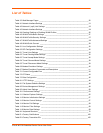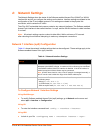
2: Introduction
xPico® Wi-Fi® Embedded Device Server User Guide 15
Configuration Methods
After installation, the xPico Wi-Fi embedded device server requires configuration. For the unit to
operate correctly on a network, it must have a unique IP address on the network. These methods
may be used for logging into the xPico Wi-Fi and assigning IP addresses and other configurable
settings:
Web Manager: View and configure settings easily through a web browser using the Lantronix
Web Manager. See “Configuration Using Web Manager” on page 17.
XML: The xPico Wi-Fi supports XML import and XML export through a terminal emulator
software such as Tera Term. See “XML Import and XML Export” on page 52.
Command Mode: Access the Command Mode (CLI) by connecting a PC or other host
running a terminal emulation program to the unit’s serial port. See “Command Reference” on
page 70.
Addresses and Port Numbers
Hardware Address
The hardware address is also referred to as the physical address or MAC address. Sample
hardware address:
00-80-A3-FF-FF-FF
00:80:A3:FF:FF:FF
IP Address
Every device connected to an IP network must have a unique IPv4 address. This address
references the specific unit.
Port Numbers
TCP Port 80: HTTP Server (Web Manager configuration)
TCP Port 10001: Tunnel (Line 1)
TCP Port 10002: Tunnel (Line 2)
Product Information Label
The product information label on the unit contains the following information about the specific unit:
Lantronix Datamatrix Code
Product Revision
Part Number
Serial Number Hardware Address (MAC Address)
Manufacturing Date Code


















